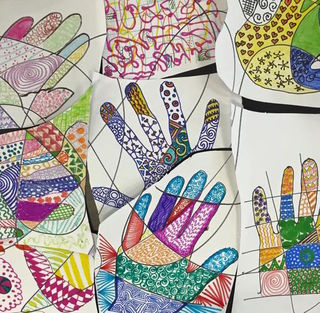Depression
Drawing on the Effort-Driven Rewards Circuit
Decreasing depression may literally be in your hands.
Posted August 4, 2008

A number of small studies claim that art therapy reduces depression through helping people with mood disorders resolve emotional problems and release repressed feelings. But maybe that is not really why art making helps to alter mood. The answer may literally be in your hands.
In a recent post, “Where Depression Might Reside,” Peter Kramer notes that both researchers and clinicians are increasingly pointing to an area of the brain known as the frontal cortex. In a similar vein, psychologist and neuroscientist Kelly Lambert proposes that the accumbens-striatal-cortical network—a system in the brain that connects movement, emotion, and thinking—is the underlying source of symptoms associated with depression. While the pre-frontal cortex in linked to the inability to concentrate (a symptom associated with depression), there are other parts of the brain that are involved, too, according to Lambert’s research. Those areas account for slow responses (accumbens), perceived loss of pleasure (striatum), and negative feelings (limbic system). These areas form what Lambert defines as the effort-driven rewards circuit.
What interests me as an art therapist and expressive therapist is Lambert’s finding that a well-engaged “effort-driven rewards circuit” helps us effectively meet emotional challenges, thus ameliorating depressive symptoms to some extent. Brain-wise, moving our hands activates larger areas of the cortex than movement of other parts of the body such as our legs or back muscles. And more importantly, what drives that effort-driven rewards circuit are physical activities that involve our hands, particularly activities that produce tangible products that we can see, touch, and enjoy. While Lambert mentions knitting or tending a garden as effort-driven reward-giving activities, I can’t help but think that this brain-hand connection applies to art making as well. “Making things” such as a drawing, painting, collage, weaving, or sculpture involve hands-on investment in an object with tangible results that give pleasure to or have meaning for their creators.
My arts in healthcare colleague Ellen Dissanayake says that art making evolved not only out of psychological need, but also as a “proto-aesthetic operation” involving using one's hands for elaboration, repetition, and manipulation, starting in early childhood. Ellen’s theory is based on how cultures throughout history have used the arts for connection, communication, and curative powers. In contrast, the 21st century seems to be a time that
Blackberries and cell phone, computer, and plasma screens increasingly take humans away from those physical, effort-driven, proto-aesthetic operations – in short, away from making things for pleasure, reward, and meaning. Lambert claims, and perhaps rightly so, that this contemporary trend is sapping our mental well being and reducing an innate resistance to depression.
So does “making things” offer a possible intervention for depression? It seems it might, at least as part of a program to treat what is not always alleviated by pharmacology plus talk therapy. While the arts serve as a means of self-expression and perhaps emotional reparation, we humans have consistently returned to the pleasure of crafting things with our hands for some more fundamental reason. Lambert’s research also brings new questions to the perennial debate about connections between depression and artists (more about that in a future post). But for now, it is exciting to know that we all may have access to an internal effort-driven rewards circuit to simply chase our blues away.
References
Lambert, K. (2008). Lifting Depression A Neuroscientist`s Hands on Approach to Activating Your Brain`s Healing Power. New York: Basic Books.


